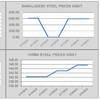Scanjet Macron completes challenging Hanseatic tank level retrofit
Scanjet Macron has completed a challenging tank level gauging system retrofit onboard Hapag-Lloyd Cruises’ MS Hanseatic during the 18-year old vessel’s 13-day dry docking at the Blohm + Voss shipyard in Hamburg. The 184-passenger ship Hanseatic is classed as the world’s only Five Star expedition ship, according to Berlitz Cruise Guide 2011.
The work was part of a comprehensive refit covering more than 780 items, including renovation and modernisation of two cabin decks, the buffet restaurant, sauna, and pool area on the 8,378 tons gross vessel.
“We knew the existing system quite well, but we had no possibility to be onboard before the docking to check what was working and could be used, what was not working, and also how to install the measuring cabinets and interface with the automation system onboard,” says Peter E. Köhler, Scanjet Macron managing director in Finland.
“Time available for the design and installation of the new system was very short. Together with the chief engineer we found easy-to-access locations for the new cabinets. Supports for the cabinets had to be made and welded and new piping for supply air to the cabinets had to be pulled. We also reduced the number of original small measuring cabinets using our larger cabinets thus saving space and costs.”
The new cabinets had to be connected to the old piping and tested for tightness. The tests showed that the piping was in relatively good condition and could be used for the Scanjet system. Some pipes were clogged, but the purging feature proved successful, even when some of the tanks had not been working for years.
“The old system communication was very special – the signal was digital with own communication protocol and converted into analogue for interfacing with the automation system,” says Mr Köhler. “We used the existing cabling and upgraded the communication to modern digital Modbus. In order to get the tank levels to the automation system, we developed completely new communication units acting like the ship’s digital automation system sending queries to the measuring cabinets for tank levels. These tank levels were then converted into analogue output signals using our converter cards and connected to the automation system.
“After some tuning our system worked perfectly. The tank levels and the draft measuring are now very accurate.”
International rules demand that all tanks influencing a vessel’s stability must be sounded for tank level. For practical reasons, remote sounding was developed many years ago on passenger ships because of the large number of tanks and compartments. Essentially, two different systems are in use - the pressure transmitter system, where the tanks pressure transmitters located at the tank side or inside the tank and the electro-pneumatic system where the sensors are in cabinets located in safe area.
Once a pressure transmitter inside a tank is damaged, this transmitter cannot be replaced unless the tank is empty and accessible. This means usually that many tanks may have no readings or false readings, and this information cannot be trusted or used in the stability calculations.
For fuel tanks, side penetration is not accepted for passenger ships due to fire risks. So also for fuel tanks the pressure transmitter must be located inside the tank. These transmitters are often damaged by pressure shocks when filling the tanks, or by high temperature inside the tanks.
Electro-pneumatic systems do not have the problems pressure transmitters have. The sensors are located inside the measuring cabinets, and are easily accessible for checking the performance of the sensors and the system. The sensors are connected to the tanks by copper or stainless steel pipes of small diameter of 8-10mm. Inside the tanks, the diameter is bigger to protect the pipes against mechanical damage.
Using the ship’s instrument air, the electro-pneumatic sensors measure the fluid pressure inside the tanks. This pressure is converted into tank levels considering the density of fluid inside the tank.
All measuring lines are automatically cleaned by the air pressure, making the system self-cleaning and another important point, according to Mr Köhler, is water ingress and flooding control. “Because our system is blowing air continuously in all tanks, also in the empty ones, there is no risk for clogging of the pipes. This feature is also utilised for water ingress detection in large compartments and voids – because the system is continuously blowing air into these any level change can be recorded and the influence of damage on the ship’s stability assessed immediately. It also provides input for establishing accurate flooding or filling rates for tanks, compartments and voids.
“Scanjet Macron’s tank level gauging system has been developed based on the extensive experience we have from various tank level gauging systems, and several hundreds of ships on which we have installed electro-pneumatic and other tank level gauging system,” says Mr Köhler.
“Our sensors have no drift and in the event of a sensor problem, performance can be checked locally in the cabinet. A damaged sensor can be replaced by the crew in less than five minutes without any calibration needed. All other tanks are measuring the tank levels when the damaged sensor is replaced – no need to shut down the system.
“Because all cabinets are on same communication line, we can call up any cabinet and tank from any cabinet, and check the performance of the sensors. There is no need to run from one cabinet to the other to check the performance.
“The system is also self-controlling. A sensor watchdog in every cabinet checks the sensor performance. In addition, alarms are shown for sensor failure, low supply air pressure, loss of power, and communication failure.”










